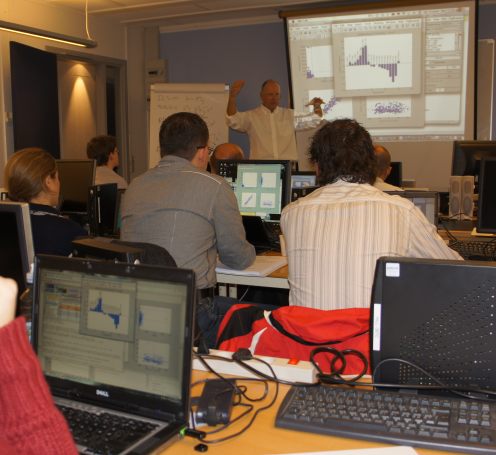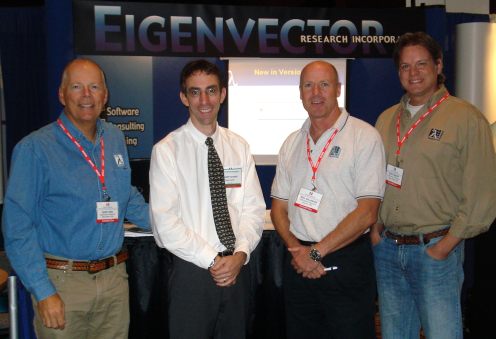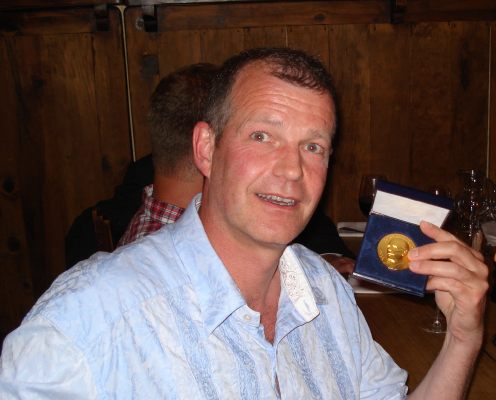Category Archives: Eigenvector News
New Releases: PLS_Toolbox/Solo/Solo+MIA 7.0, MIA_Toolbox 2.8
Oct 30, 2012
New versions of our MATLAB-based PLS_Toolbox and MIA_Toolbox were released earlier this month, along with updates to our stand-alone packages Solo and Solo+MIA. PLS_Toolbox and its derivatives, Solo and Solo+MIA, are now in version 7.0, while MIA_Toolbox is in version 2.8. As can be seen in the release notes, the list of enhancements and additions is long (as usual!).
Many of the new features are demonstrated in the new EigenGuide video, “What’s New in Version 7.0.” The video illustrates the use of:
- additional information in the Analysis interface, such as error of cross-validation
- interfaces for splitting data sets into calibration and validation sets
- tools for visualizing the difference between samples for both their Q residuals and T2 contributions
- simplified control of plot attributes
- readily available class statistics
- automated peak finding
- tools for finding specific samples and variables based on logical operators
Of particular note in this release is the expansion of the Batch Process Modeling tools. The Batch Processor tool readies data sets for modeling by Summary PCA, Batch Maturity, MPCA, and several PARAFAC variants. It then pushes the data sets into the Analysis tool where the models are developed. To see the Batch Processor and Analysis in action, watch the video. The combination of the Batch Processor and methods supported in the Analysis interface allows modelers to follow most of the pathways outlined in my TRICAP 2012 talk, “Getting to Multiway: A Roadmap for Batch Process Data.”
This release reaffirms EVRI’s commitment to continuous software improvement – it completes our fifth year of semiannual major releases. The best chemometrics software just keeps getting better!
BMW
Thanks to FOSS!
Oct 25, 2012
Rasmus Bro and I wrapped up another short course today, this time at FOSS World Headquarters in Hillerød, DENMARK. We’d like to thank our students, another great group, and especially our host at FOSS, Lars Nørgaard, Senior Manager of FOSS Team Chemometric Development. Lars makes it easy for us to hold this course as the meal and coffee service arrangements are all done through the excellent FOSS Canteen, and they also provide a very comfortable classroom.
This was our second year at FOSS, and we’re planning on making it a regular thing, our Eigenvector University Europe. Next year we’ll be in FOSS’ new “Innovation Centre,” due to be completed this winter. We’re certain it will provide a great venue for EigenU Europe, 2013. Exact dates are TBD, but we’re looking once again at the last half of October.
Thanks again to the kind folks at FOSS!
BMW
Chemometrics without Equations Extended at EAS
Oct 17, 2012
The popular Chemometrics without Equations (CWE) series will be extended at the Eastern Analytical Symposium (EAS) this year with the addition of a second day, CWE II. While the original CWE focuses on the basics of Principal Components Analysis (PCA) and Partial Least Squares (PLS) regression, CWE II will explore advanced data preprocessing methods and mixture analysis.
I have been known to say that the secret to getting good regression models is what you do before the data hits the modeling algorithm. Preprocessing methods attempt to remove extraneous variance so that the variance of interest can be more easily modeled. When done correctly, preprocessing can greatly improve model performance. CWE II covers the whys and hows of data preprocessing with examples from several methods.
Also covered in CWE II, Mixture analysis techniques, such as Multivariate Curve Resolution (MCR) aka Self-Modeling Mixture Analysis (SMMA), can elucidate the true underlying physical roots of the data, e.g. pure component spectra and chemical concentrations. As such, these methods can lead to better fundamental understanding of the systems involved.
The courses will be led by Dr. Don Dahlberg, Emeritus Professor at Lebanon Valley College. Don will be assisted by EVRI’s Chief of Technology Development Dr. Jeremy M. Shaver.
The courses will be held Sunday and Monday, November 11 and 12, at the Holiday Inn in Somerset, NJ. Registration is handled by EAS. Complete course information can be found in EAS’s Short Course Schedule and Description.
BMW
Introducing Megan Kogut
Oct 16, 2012
Megan Kogut, Ph.D., joined our staff last month as our new Director of Strategic Communications. Like many of her fellow Eigenvectorians, Megan comes with a unique and distinctive set of qualifications.
Dr. Kogut received her Ph.D. in Environmental Engineering from Massachusetts Institute of Technology in 2002. Since then she’s held several positions, including lecturer at University of Washington‘s Tacoma campus, and Environmental Quality Unit Manager at UW Seattle. Through these positions, Megan discovered that she really liked the communication aspects of her job. “For me, writing flyers and newsletter articles is like tightrope walking, balancing detail, enthusiasm and humor. And, I love connecting people through email and on the phone. I have done this professionally and as a hobby for the last ten years or more.”
Megan also noted that EVRI appealed to her scientific side. “I love data analysis and interpretation, especially in situations with many variables. Usually, research of the environment involves isolating natural processes as much as possible without ignoring important inputs or influences. Many scientists struggle with oversimplification, and some just cheerfully throw a rock at their subject without even acknowledging all the variables.” To that we say, “Amen!”
We’re excited about having a new member of our team, and confident our customers will benefit from having a staff member dedicated to getting our message out.
Welcome Megan!
BMW
Off to SCIX 2012 in Kansas City
Sep 25, 2012
EVRI will have a strong presence at SCIX 2012 (formerly FACSS) next week, September 30 to October 5. Eigenvectorians Jeremy Shaver, Bob Roginski and Randy Bishop will be busy teaching, speaking and representing Eigenvector.
EVRI is offering two hands-on short courses at SCIX: Chemometrics without Equations (CWE) and the follow-on Advanced Chemometrics without Equations (ACWE). CWE will be presented as a two-day course, September 30-October 1 (Sunday-Monday), while ACWE is one day, October 3 (Wednesday). Jeremy, Bob and Randy will be tag-teaming as instructors, so participants will get a chance to interact with all three of them. They each have abundant experience in the field of chemometrics, but somewhat different perspectives, so it should make for lively courses. Registration can be done on-site.
As usual, EVRI will be involved with the Technical Sessions. At 2:20 Monday afternoon Jeremy will present “Data Sampling for Extending the Life of NIR-based Models” in Chicago C. This talk deals with the problem of updating models using historical (non-designed) data. Methods for selecting data subsets are compared relative to the goal of improving the model while minimizing costs. Bob will present the poster “Target Detection Applied to Detection of Adulterants in Powdered Raw Material using Near Infrared Hyperspectral Imaging” at the Wednesday morning poster session in the Exhibit Hall. An application of detecting melamine in wheat gluten is shown.
The Exhibit opens Monday evening with a reception from 5:30 to 7:30. This is always a fun event, so be sure to stop by Booth 47 for your complimentary Eigenvector Bottle Opener. The Exhibit is also open Tuesday 9:00-4:30 and Wednesday 9:00-4:00. The Eigenguys will be demoing the upcoming PLS_Toolbox and Solo version 7, to be released this fall.
Jeremy will also represent Eigenvector on the panel of the Student Free Lunch and Employment Discussion on Tuesday.
It will be a busy week. Have fun, Jeremy, Bob and Randy!
BMW
By Popular Demand: EigenU Online
Jun 22, 2012
At the last several editions of Eigenvector University (aka EigenU) our beginning track courses have been consistently overbooked. This includes the first three days of courses consisting of Linear Algebra for Chemometricians, MATLAB for Chemometricians, Chemometrics I: PCA, and Chemometrics II: Regression and PLS. There were also EigenU attendees with schedule conflicts that made it impossible for them to attend some of these courses, but they needed the background to attend other EigenU courses.
Therefore, due to popular demand, we’ve created EigenU Online. EigenU Online allows users to get chemometrics training on their own schedule and at their own desk. The material covered is the same as in their EigenU counterparts. Courses consist of video lectures using both slides and software demonstrations, plus course notes in .pdf format. Additional materials and data sets are included for some courses.
The goal of the EigenU Online courses is to provide students the background they’ll need to understand the chemometric methods presented and accomplish typical modeling tasks in PLS_Toolbox and Solo. But, like our EigenU courses, they aren’t just about using software! No matter whose software you use, you’ll be a better user after EigenU Online.
We’ve made a couple segments of our online courses available free for your evaluation. Just login to your Eigenvector account, or create one. Under the EigenU Online tab you’ll see a link to the lecture Classical Least Squares – Introduction, and to Classical Least Squares – Hands-on Example which shows how the course software demonstrations work.
For complete information, see the EigenU Online page. Still have questions? Write to me at bmw@eigenvector.com.
BMW
EigenU 2012 Poster Session Winners
May 21, 2012
EigenU 2012, the Seventh Annual Eigenvector University, was held last week at the Washington Athletic Club in Seattle. Our Tuesday evening PLS_Toolbox/Solo User poster session gave EigenU attendees a chance to unwind with hors d’oeuvres and beverages and discuss some chemometric applications. This year’s posters were judged by Paul Geladi, professor of Chemometrics at SLU, the Swedish University of Agricultural Sciences.
Bob Moision of Aerospace Corp. claimed first prize with “Application of MCR to VIIRS On-Orbit Anomaly Investigation.” Bob’s poster described how multivariate analysis was used with ToF-SIMS data in an investigation into the cause of the unexpected poor sensitivity of the Visible/Infrared Imager Radiometer Suite (VIIRS) on the Suomi National Polar-orbiting Partnership satellite. Bob is show below accepting his Apple iPod nano.
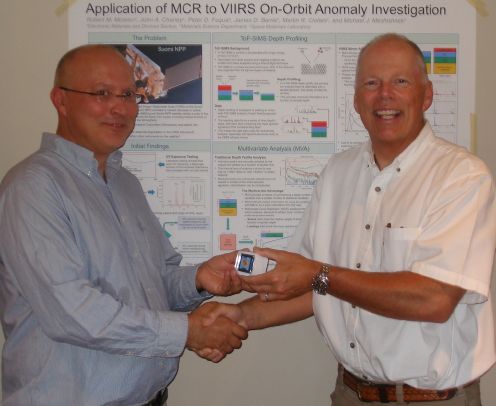
Second prize was awarded to Gordon Allison of Aberystwyth University for “Diagnosis of TSE disease in cattle and sheep using metabolomic analysis and computer learning technologies- GC/MS approaches.” The poster summarized results of a project aimed to identify novel, non-prion markers of transmissible spongiform encephalopathy (TSE) disease in samples of blood plasma from infected cattle and sheep that consistently indicate infection and which could be used for disease diagnosis in living animals before the appearance of clinical symptoms. Gordon is shown below accepting his nano from Eigenvector Vice-President Neal Gallagher.
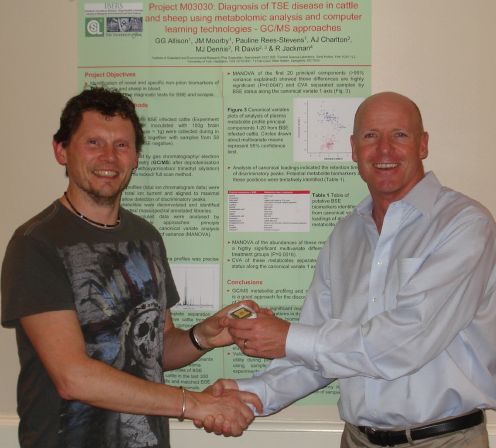
This year’s poster session included a father-daughter project: Clare Wise presented “Analysis of Historical Stehekin River Flow Data with Principal Components Analysis and Multivariate Curve Resolution.” The poster described how PCA and MCR can be used on the daily Stehekin River flow data to model spring runoff and to find interesting years since measurements were started in 1927. Clare, who will be a freshman in Chemical and Biological Engineering at the University of Colorado next fall, is shown with her poster, and me, below.

Thanks to everyone who presented and attended this year’s poster session!
BMW
iPods Ordered!
Apr 27, 2012
The Seventh Annual Eigenvector University starts in just over two weeks on Sunday, May 13, 2012. We’re looking forward to a busy week, including the PLS_Toolbox/Solo User Poster Session. This Tuesday evening event showcases research done by our users. Presenters of the two best posters go home with Apple iPod nanos. I ordered them today, both 16GB, one orange, one blue, and both engraved with “EigenU 2012 Best Poster.”
The complimentary poster session is always a great time for EigenU participants to relax, have a beverage, and talk about chemometric applications. Attendance at EigenU courses is not required to present a poster, and we often get grad students from University of Washington and other Seattle area research centers.
Interested in presenting? Just send an abstract for your poster that describes work where you’ve used our software.
See you in a couple weeks!
BMW
Top 10 Reasons to come to EigenU 2013
Apr 4, 2012
If you are in the market for training in multivariate methods you have a number of choices. In North America, you could attend classes given by CAMO, ProSensus, or Umetrics. Here are 10 reasons you should come to the 8th Annual EigenU 2013, May 12-17 in Seattle, instead:
- More experienced instructors – Courses at EigenU 2013 will be led by the EVRI staff including Neal B. Gallagher, Jeremy M. Shaver, Robert T. Roginski, and Randy Bishop, plus our Associate Rasmus Bro, and of course myself. Together we’ve got over 100 man-years of chemometric experience.
- Wider variety of courses – In addition to our beginning track including PCA and PLS, we offer 11 advanced and specialty courses including Robust Methods, Calibration Transfer/Instrument Standardization, Batch SPC, Variable Selection and Multivariate Image Analysis. Plus new this year, we have the Bring Your Own Data (BYOD) Workshop where you’ll be able to work with your own data while you learn hands-on with EVRI’s team of instructors.
- Method-centric instruction – At EigenU we provide the background required to truly understand chemometric methods; we don’t just show you what buttons to push. Our goal is to make the literature in the field accessible to our graduates. Deeper understanding of the methods leads to better analysis!
- Beautiful Seattle, WA – With Puget Sound and the Olympics to the West and Lake Washington and the Cascades to the East, the Emerald City is distractingly scenic. Plus, it is home to the Space Needle, Pike Place Market, Seattle Art Museum, Seattle Mariners, the largest ferry system in the US, plus tons of other attractions. It is definitely not New Jersey!
- The Washington Athletic Club – EigenU is held at the WAC, the nation’s premier city athletic club. The historic 21 story facility includes 5 floors of fitness facilities, 10 floors of Euro-styled techno-centric sleeping rooms, full service spa, and 3 restaurants.
- The food – From the continental breakfast, including the WAC’s signature sticky buns, through the gourmet plated lunches, to afternoon snack bars, our guests always rave about the food.
- Networking – EigenU attendance is typically about 40 scientists and engineers with a range of chemometric expertise and wide variety of interests. This means you’ll have plenty of opportunity to find colleagues with common problems and complimentary solutions.
- Evening events – EigenU provides ample opportunity to continue your chemometric learning and networking into the evening. This includes Tuesday’s PLS_Toolbox/Solo User Poster Session, Wednesday’s PowerUser Tips & Tricks Session, and Thursday’s Workshop Dinner, which is one more opportunity to enjoy the WAC’s fabulous food. Present a poster at the Tuesday evening User Session and you could win an Apple iPad mini or iPod nano!
- Flexible, multi-platform software – With PLS_Toolbox, MIA_Toolbox and EMSC_Toolbox, EVRI offers the most comprehensive set of chemometric tools available plus the flexibility of MATLAB. Our stand-alone packages Solo and Solo+MIA offer all the point and click tools of their MATLAB-based siblings. Plus they’re all available for Windows, Linux and MacOS. On-line options available too!
- Costs less – In spite of all its advantages, EigenU actually costs less than similar courses from CAMO, Umetrics and ProSensus.
So it probably isn’t surprising that EigenU attendees are more than satisfied. Here’s what a couple of them had to say:
“I attended the Eigenvector University 2010 earlier this year. It was the best short-course I have ever taken on any subject. I highly recommend it if you’re looking for a short-course, immersion kind of training.” – James M. Roberts, GSK
“What you are offering here is unmatched.” – David A. Russell, Dupont.
Discount registration ends soon, register and pay by April 10 for the best prices.
See you at EigenU!
BMW
New Releases: PLS_Toolbox and Solo 6.7, MIA_Toolbox 2.7
Mar 20, 2012
Updates to our flagship PLS_Toolbox and Solo were released last week; they are now in version 6.7. This is in keeping with our policy, (began in 2008), to release significant upgrades twice yearly. Our Multivariate Image Analysis (MIA) tools were also updated with the release of Solo+MIA 6.7 and MIA_Toolbox 2.7.
As the Version 6.7 Release Notes show, the number of additions, improvements and refinements is (once again!) rather long. My favorite new features are the Drag and Drop import of data files, Confusion Table including cross-validation results for classification problems, and Custom Color-By values for plotting.
PLS_Toolbox/Solo can import a wide variety of file types, and the list continues to grow. Drag and Drop importing allows users to drag their data files directly to the Browse or Analysis windows. They will be loaded and ready for analysis. For instance, users can drag a number of .spc files directly into Analysis. Forget some files or have additional files in a different directory? Just drag them in and they will be augmented onto the existing data.
The Confusion Table feature creates several tables summarizing the classification performance of models. This includes a “confusion matrix” giving fractions of true positive, false positive, true negative, and false negative samples and a confusion table which gives number of samples the actual and predicted classes. Tables are calculated for both the full fitted model and for the cross-validation results. The tables can be easily copy and pasted, saved to file, or can be included in the Report Writer output as html, MS Word or PowerPoint files.
With Custom Color-By users can color points in scores and loadings plots using any currently loaded data or with new data loaded from the workspace. For instance, samples in a PLS LV-2 versus LV-1 scores plot can be colored by the scores on another LV, their actual or predicted y values, leverage, Q residual, specific X-variable, additional Y-variable, or any custom variable from the work space. The allows deeper investigation into the cause of specific variations seen in the data.
Want to find out more about our latest releases? Create an account in our system and you’ll be able to download free 30-day demos. Want prices? No need to sit through a webinar! Just check our price list page, which includes all our products. Just click Academic or Industrial.
As always, users with current Maintenance Agreements can download the new versions from their accounts.
Questions? I’d be happy to answer them or refer you to our development team. Just email me!
BMW
2011 EAS Awards for NIR and Chemometrics
Nov 17, 2011
I had the privilege of being involved with two award sessions at this week’s Eastern Analytical Symposium (EAS). I was very pleased to be invited to speak in the session honoring former Eigenvectorian Charles E. “Chuck” Miller for Outstanding Achievements in Near Infrared Spectroscopy. Chuck elected to have talks from speakers that represented phases in his career. This included Robert Thompson, Chuck’s advisor from Oberlin College, Tormod Næs, from his time at University of Washington’s Center for Process Analytical Chemistry (CPAC) and Matforsk (now Nofima), Cary Sohl of DuPont, and myself. Chuck, now with Merck, presented “26 Years of NIR Technology – From One Person’s Perspective,” which chronicled his career and influences, along with the progression of NIR over the period.
The session was organized by Katherine Bakeev of CAMO. Pictured below are Katherine, Tormod, Cary, Chuck, EAS President David Russell, and myself.

The session provided ample evidence of the intertwined evolution of chemometrics and NIR, with two primarily chemometric talks and two NIR talks with aspects of chemometrics.
I was also our representative at the session honoring Beata Walczak of the University of Silesian in Poland. Beata was the recipient of the EAS Award for Outstanding Achievements in Chemometrics, sponsored once again by Eigenvector Research. Beata and I are pictured below with the award.
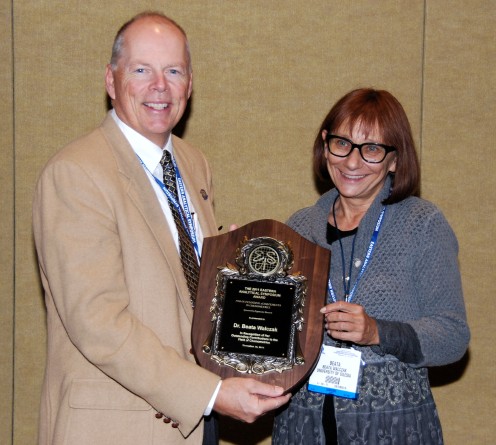
The award session, organized by Peter D. Wentzell of Dalhousie University, had an “omics” theme with talks on metabolomics and proteomics. Speakers included Peter, Tobais Karakach of the Institute for Marine Biosciences, Sarah Rutan of Virginia Commonwealth University and Michal Daszykowski, also of Silesian. Beata presented “Chemometrics in Proteomics,” an overview of her work in the field highlighting methods for aligning samples from 2-D gel electrophoresis.
Congratulations to both Chuck and Beata on two very well-deserved awards!
BMW
What’s in a Logo?
Nov 7, 2011
Branding is an important aspect of promoting a business and central to that is developing an identifiable logo. I like logos, (and sometimes wish I could be a graphic designer). The best logos, besides looking great, have a deep connection to the thing they represent. Coming up with a good one is quite an exercise.
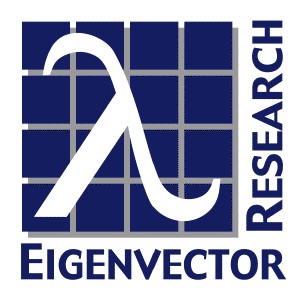
When Eigenvector was working on a new website design in ~1998 we hired Chris Raines of Sun Graphic and now Cevado. Chris thought that we should first design a new logo and started by asking questions about what we do and how we got the name Eigenvector. I explained that we basically analyzed large tables of data, i.e. big matrices, and that Eigenvectors were central to the types of analysis we do. Besides, I’d always liked the idea that an eigenvector was a “proper” direction in a data analysis problem, and I like to think that we are moving our clients in the “proper” direction. I then wrote down the equation Ax = λx. Pointing to the Greek letter lambda, Chris asked, “What’s the swoopy thing?” I replied, “Generally, people use lambda to represent the eigenvalue in the eigenvector equation.” Chris said, “We have to use the swoopy thing!”
From that, Chris produced the logo that we use today, shown above. The four by four set of boxes represent a matrix, and the “swoopy thing” the matrix eigenvalue(s). Eigenvalues, more than any other parameters, describe the structure of matrices, and are important in our work. When we need a roughly square logo, we put “Eigenvector” on the bottom and “Research” up the side, like a matrix outer product. We use outer products all the time to analyze and approximate matrices as in Principal Components Analysis (PCA).
So what’s in a logo? If it’s a good one, quite a lot!
BMW
FOSS Course Conclusion
Oct 27, 2011
Our Basic/Intermediate Chemometrics course at FOSS in Hillerød, Denmark, concluded today. It has been a good week; Rasmus and I have really enjoyed it. We’ve had lots of good discussion with plenty of examples offered by class members. And our students have been very attentive–note that they have the same thing on their screens as I have on mine!
Many thanks to FOSS and especially Lars Nørgaard for inviting us here. FOSS took good care of us, providing ample coffee, great snacks for breaks, and great lunches in their cafeteria. We’ve also had a couple nice evenings out, including a very nice dinner at Ristorante La Perle. We can see why everybody in Hillerød goes there for their birthday.
Thanks to everyone who attended!
BMW
Off to Hillerød
Oct 20, 2011
I’m leaving in the morning to go to Hillerød, Denmark, where we are holding a Beginning/Intermediate Chemometrics course. I’ll be teaching with Rasmus Bro, which I always enjoy. Rasmus has a very relaxed lecturing style and is very good at explaining chemometric concepts. I always learn something, even when it is about subjects I’m already pretty good at.
The course will be held at FOSS World Headquaters. FOSS is very big in applications of spectroscopy to problems in food and beverages, grain, feed, meat etc. Chemometrics is a critical part of this and FOSS has a substantial chemometrics group. That group is headed up by Lars Nørgaard, the former Head of the Department of Food Science at University of Copenhagen.
I think of Lars more as a chemometrician, however, rather than a manager. PLS_Toolbox owes a number of things to Lars, including Inteval-PLS (iPLS) and ‘color-by.’ iPLS is a method for selecting variables and also elucidating from which part of the spectrum calibration models get their predictive information. The ‘color-by’ feature uses the color of data points in a plot to indicate the value of another variable. It really helps spot trends. I first saw this feature in LatentiX, with which Lars was involved.
We have a nearly full class lined up and with Lars, Rasmus and myself it should make for a lively group. Plus, we’ll be teaching with the just released PLS_Toolbox 6.5. I’ll need to spend some time learning about 6.5’s new features myself. I’m looking forward to it!
BMW
Multi-platform Chemometrics Software
Oct 14, 2011
When I go to conferences I often look around to see what sort of computers people are using. In the past year or so I’ve noticed a significant uptick in the number of Macs. At SSC-12, SIMS-XVIII and FACSS/SCIX-2011 Macs accounted for about half of the laptops that I saw in use in the technical sessions and the trade shows.
So, who is making chemometrics software for anything besides Windows? Umetrics isn’t. SIMCA is Windows only. CAMO isn’t. Unscrambler® X is Windows only. Infometrix isn’t. Pirouette® is Windows only. The answer, of course, is Eigenvector Research. Because MATLAB® is available on all platforms, EVRI’s flagship PLS_Toolbox, plus our MIA_Toolbox and EMSC_Toolbox work on Mac OS X, Linux and Windows too. And that includes the 64-bit versions!
Don’t have MATLAB? Not a problem. Our stand-alone packages Solo and Solo+MIA also run on all platforms, including the 64-bit versions. Even our on-line prediction engine, Solo_Predictor, runs on all platforms.
So, besides the fact that PLS_Toolbox and Solo support a wider array of chemometric methods and preprocessing options, and the fact that their point-and-click interfaces are highly intuitive, you can add the fact that they run on more than just Windows. And as if that weren’t enough, they also cost less.
So if you are looking for great chemometrics software that runs in a multi-platform environment, EVRI has solutions for you!
BMW
Unscrambler® is a registered trademark of CAMO, Inc.
Pirouette® is a registered trademark of Infometrix, Inc.
MATLAB® is a registered trademark of The MathWorks, Inc.
Report from FACSS
Oct 6, 2011
This year’s Federation of Analytical Chemistry and Spectroscopy Societies meeting (FACSS) was quite vibrant. The number of participants was up from recent years, with close to 1200 registrants. Attendance at the technical sessions and traffic at the exhibit was good.
As usual, EVRI was there in force. Our booth crew is shown above, including me, Chief of Technology Development Jeremy M. Shaver, Vice-President Neal B. Gallagher, and Senior Research Scientist Randy Bishop.
 We especially enjoyed the Monday evening reception, where we gave away beer in our Eigenvector logo bottle koozies. Anna Cavinato of Eastern Oregon University is shown at left with a beer and koozie along with all the usual trade show accoutrements (including badge, necklace, wine glass, frisbee, product literature, t-shirt, etc.). We also made sure we were first in line on Tuesday when HORIBA Scientific gave away free hot dogs and beer for lunch.
We especially enjoyed the Monday evening reception, where we gave away beer in our Eigenvector logo bottle koozies. Anna Cavinato of Eastern Oregon University is shown at left with a beer and koozie along with all the usual trade show accoutrements (including badge, necklace, wine glass, frisbee, product literature, t-shirt, etc.). We also made sure we were first in line on Tuesday when HORIBA Scientific gave away free hot dogs and beer for lunch.
The organizers of FACSS also announced that the conference name has been changed to SCIX, short for Scientific Exchange. SCIX 2012 will be in Kansas City, Missouri.
As noted in the previous post, the Eigenvectorians also presented four talks, Jeremy co-taught the Analytical Raman Spectroscopy Workshop, Neal co-chaired a session on General Forensics, and Eigenvector sponsored sessions on Chemometrics and Data Fusion and Chemometrics for Process Analysis. On top of that there was booth duty, attending talks, reviewing posters, and the Raman and SAS receptions. It was a busy time!
EVRI would like to thank the organizers of FACSS 2011, especially Exhibits Chair Mike Carrabba, Workshop Chairs Brandye Smith-Goettler and Heather Brooke, and of course Cindi Lilly and her crew. Great meeting! See you next year!
BMW
Off to FACSS, PLS_Toolbox/Solo 6.5
Sep 30, 2011
The Federation of Analytical Chemistry and Spectroscopy Societies (FACSS) annual meeting starts this Sunday, October 2, in Reno, NV. The EVRI crew headed there includes Neal B. Gallagher (NBG), Jeremy M. Shaver (JMS), Randy Bishop (RB), and myself (BMW). We expect to be busy! We have a number of papers to give, listed below.
- Visualizing Results: Data Fusion and Analysis for Hyperspectral Images, by JMS, Eunah Lee and Karen Gall, Monday, 2:30pm
- Detection of Adulterants in Raw Materials Utilizing Hyperspectral Imaging with Target and Anomaly Detection Algorithms, by Lam K. Nguyen and Eli Margilith of Opotek, NBG and JMS, Tuesday, 4:50pm
- Multivariate Modeling of Batch Processes Using Summary Variables, by BMW and NBG, Wednesday, 10:30am
- A Comparison of Detection Strategies for Solids and Organic Liquids on Surfaces Using Long Wave Infrared Hyperspectral Imaging, by NBG, and Thomas A. Blake and James F. Kelly of PNNL, Wednesday, 1:50pm
We’ll also be in the exhibition hall in Booth #29 demoing the soon-to-be released PLS_Toolbox/Solo version 6.5. As usual, our programing team has been very productive, and the list of new features in 6.5 is very long. We’re especially excited about the new Design of Experiments tools and the streamlining and unification of all our Classification Methods. Stop by and have a look, we’d sure like to show you what’s new.
See you there!
BMW
Report from SIMS XVIII
Sep 26, 2011
The eighteenth meeting on Secondary Ion Mass Spectrometry, SIMS XVIII, was held last week in Riva del Garda, Italy. The meeting has been held biannually starting in 1977. As Nicolas Winograd pointed out in the opening lecture, it is a testament to the importance and vibrancy of the field that such a specialized meeting has continued to thrive. SIMS XVIII attracted nearly 400 participants divided roughly equally between Asia, the Americas, and Europe, with Asia being the somewhat largest third and the Americas the smallest.
I was pleased to see an increase in the number of papers that utilized multivariate analysis (MVA) in general and PLS_Toolbox and MIA_Toolbox in particular. In her talk, “Critical Issues in Multivariate Analysis of ToF SIMS Spectra, Images and Depth Profiles,” Bonnie Tyler noted that the number of publications in SIMS utilizing MVA is currently exponentiating, a trend which started about 10 years ago. Interestingly, I first taught a course utilizing SIMS data in 2001 at the Sanibel Island ASMS Meeting. That said, I still saw plenty of presentations and posters with 8-12 images at different AMUs that all looked the same: instances where PCA would result in a drastic reduction in the number of images to review plus some corresponding noise reduction.
Interesting talks where our software was used included:
- “ToF-SIMS Technique for Nano-Surface Analysis of Biosensors and Tissues” by Tae Geol Lee, Ji-Won Park, Sojeong Yun, Heesang Song, Hyegeun Min, Hyun Jo Jung, Taek Dong Chung, Ki-Chul Hwang, Hark Kyun Kim, Dae Won Moon and Daehee Hwang
- “Development of ToF-SIMS Enzyme Screening Assays” by Robyn Goacher, Elizabeth Edwards, Charles Mims and Emma Master
- “Evaluation of white radish sprouts growth influenced by magnetic fields using TOF-SIMS and MCR” by Satoka Aoyagi, Katsushi Kuroda, Ruka Takama, Kazuhiko Fukushima, Isao Kayano, Seiichi Mochizuki and Akira Yano
- “Multivariate Image Analysis of Chemical Heterogeneities Observed in Microarray Printed Polymers” by David Scurr, Andrew Hook, Daniel Anderson, Robert Langer, Morgan Alexander and Martyn Davies
I presented “Deconvolving SIMS Images using Multivariate Curve Resolution with Contrast Constraints,” by myself and Willem Windig. The talk demonstrated how in MCR contrast can be maximized in either the estimated spectra or concentrations/images. The solutions for each of these cases will give an indication of the range of solutions in the given MCR problem which all fit the data equally well. In many instances, one of the two solutions will be preferred, or both may be interpretable to illustrate different features of the data.
SIMS XVIII also included another installment of our “Chemometrics in SIMS” course. I was happy to present this course to another eager group of future chemometricians!
The SIMS XVIII conference was a great success. The technical program was very interesting and went off without a hitch. Riva del Garda is a beautiful location, perhaps the most scenic conference venue I have experienced. Congratulations to the organizers! I’m already looking forward to SIMS XIX in Jeju Island, Korea in 2013.
BMW
Solo 6.3 Released
Jun 30, 2011
Version 6.3 of our Solo software products were released this week. This includes the core Solo package, Solo+MIA and Solo+Model_Exporter. This release includes significant improvements to underlying libraries to make Solo faster, more memory friendly, make better use of multi-core processors, and have a more modern look and feel. Details can be found on the Solo 6.3 Release Notes page.
Solo+Model_Exporter 6.3 incorporates the latest Model_Exporter 2.5 which adds support for more preprocessing methods, improved memory support, and includes the freely-distributable .NET prediction engine (Model_Exporter Interpreter) for 3rd party integration. For detailed information, please see the Model_Exporter 2.5 Release Notes.
I asked our Chief of Technology Development, Jeremy M. Shaver, a few questions about the release.
BMW: Can Solo users expect to see performance gains?
JMS: If you use a system with multiple cores, or regularly work with data that is graphically-intensive or generally large, you should expect to see performance gains. If you are using Windows Vista or Windows 7, you can expect to see interfaces which are more consistent with the operating system’s overall look and feel.
BMW: What does this mean for people trying to get models on-line?
JMS: The changes to Solo+Model_Exporter include more support for models with complex preprocessing and improved memory handling. It also includes the new freely distributable .NET object Model_Exporter Interpreter. This object can be integrated into third party .NET applications to easily get exported Solo models on-line. There is no royalty payments associated with either exporting a model or distributing the Interpreter.
BMW: Any impact for hand-held devices?
JMS: The Model_Exporter improvements in memory management also make exported Solo models more hand-held device friendly. In addition, the Model_Exporter Interpreter also makes integrating these models into existing applications much easier.
For more information about what’s been added to Solo (and PLS_Toolbox) in recent releases please see the PLS_Toolbox/Solo Release Notes.
Solo users with current maintenance contracts can upgrade now. Free demos are also available to those with accounts in our system. Don’t have an account? Start by creating one.
BMW
Rasmus Bro Wins Wold Medal
Jun 9, 2011
The 10th Wold Medal was presented at the Scandinavian Symposium on Chemometrics, SSC12, in Billund, Denmark, this evening. Professor Rasmus Bro accepted the award from past winner Johan Trygg of Umeå University. Rasmus credited Lars Munck for development of the group at University of Copenhagen and enabling him to flourish there. He also mentioned the late Sijmen de Jong as being one of the great people he worked with and dedicated the award to him.
The Wold Medal, named for Herman Wold, father of Partial Least Squares (PLS) methods, honors individuals who have contributed greatly to the field of chemometrics. Rasmus is a worthy recipient, having published over 100 papers in the field, particularly in multi-way analysis. Prof. Bro is also know for his teaching, MATLAB-based multi-way software, and as being a great ambassador for the field. Rasmus is shown below with the Wold medal.
Past recipients of the Wold medal include Svante Wold, Agnar Höskuldsson, Harald Martens, John MacGregor, Rolf Carlson, Olav Kvalheim, Pentti Minkinen, Michael Sjöström and Johan Trygg.
Congratulations Rasmus! Well deserved!
BMW

 SEARCH
SEARCH